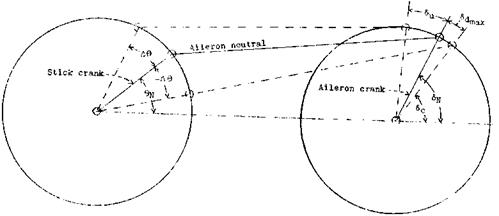Aileron Differential
The larger travel of one aileron relative to the other is called aileron differential (Figure 5.7). Aileron differential is a method of reducing control forces by taking advantage of hinge moment bias in one direction (Jones and Nerkin, 1936; Gates, 1940). At positive wing angles of attack, the hinge moment acting on both ailerons is normally trailing-edge – up, and we say the ailerons want to float up. Assume that the up-going aileron is given a larger travel than the down-going aileron for a given control stick or wheel throw. Then, the work done by the trailing-edge-up hinge moment acting on the up-going aileron can be nearly as great as the work the pilot does in moving the down-going aileron against its up-acting hinge moment, and little pilot force is needed to move the combination. The differential appropriate for up-float is more trailing-edge-up angle than down. Typical values are 30 degrees up and 15 degrees down. The floating hinge moment can be augmented, or even reversed, by fixed tabs.
|
Figure 5.7 The principle of aileron differential, or unsymmetrical up and down travels. Stick crank motions A& of the same amount on each wing cause larger up-aileron deflections Su than down-aileron deflections Sdmax. (From Jones and Nerkin, NACA TN 586, 1936) |
Aileron up-float, associated with negative values of the hinge moment derivative Cha, is greatest at high wing angles of attack. Neglecting accelerated flight, high wing angles of attack occur at low airspeeds. Thus, aileron differential has the unfortunate effect of reducing aileron control forces at low airspeeds more than at high airspeeds, where reductions are really needed. In addition to the force-lightening characteristic of aileron differential, increased up relative to down aileron tends to minimize adverse yaw in aileron rolls, which is the tendency of the nose to swing initially in the opposite direction to the commanded roll.
Adverse yaw in aileron rolls remains a problem for modern airplanes, especially those with low directional stability, such as tailless airplanes. Where stability augmentation (Chapter 20) is available, it is a more powerful means of overcoming adverse yaw than aileron differential.















